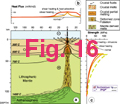


- From the geometry of various geological formations, total left-lateral offset on the ASRR is estimated at 700±200 km (Fig. 14) (Leloup et al., 1995, Chung et al., 1997, Leloup et al., 2001).
- Paleomagnetic results in Mesozoic series on both sides of the ASRR suggest a southward motion of Indochina of 6 to 12° (10±3° on average) with respect to South China (Sato et al., 1999; Yang et al., 1995). Such difference would corresponds to more than 1400±400 km of motion along the ASRR but may incorporate deformations outside of the shear zone (Leloup et al., 2001).
In the metamorphic cores of the ASRR, left-lateral shear that was ongoing at high temperatures pursued during cooling of these ranges (Fig. 15) (Leloup et al., 1993; Leloup and Kienast, 1993; Leloup et al., 2001). P-T estimates based on garnet chemical zoning and garnet-biotite and garnet-sillimanite-plagioclase-quartz thermobarometry show that left-lateral strain occurred in the DayNuiConVoi, Ailao Shan and Diancang Shan ranges under a very high geothermal gradient, from amphibolite facies (3-7 kb & 550-780 °C) to greenschist facies (<3.8 kb & 500°C) conditions (Fig. 15) (Leloup and Kienast., 1993, Leloup et al., 1993, 2001).
In all ranges high temperature shear was coeval with felsic magmatic activity that lasted at least from 33 to 22 Ma (Schärer et al., 1990; 1994; Zhang and Schärer, 1999). Such magmas resulted mostly from lower crustal melting which was probably enhanced by shear heating in the upper mantle (Fig.16) (Leloup and Kienast, 1993, Leloup et al., 1999).
The cooling history of the whole shear zone, based on more than one hundred 40Ar/39Ar ages (Figs. 17, 18), shows that the four ranges forming the ASRR, have their own cooling histories. However, all these cooling histories show two main episodes of rapid cooling separated by a period of slower cooling: cooling (I) from peak metamorphism during left-lateral shear, and cooling (II) from greenschist conditions during right-lateral reactivation of the ASRR (Fig.17, 18b) (Harrison et al., 1992; 1996, Leloup et al., 1993; 2001). The timing of cooling (I) differs in the different ranges (32 Ma in the XLS, 24 Ma in the DCS and 28 Ma in the DNCV) and is diachronic along strike in the Ailao Shan (from 28 to 18 Ma) (Figs. 17 and 18) (Harrison et al., 1996; Leloup et al., 2001). During cooling (I), denudation rates were 0.4 mm/yr. (Diancang Shan) and 1.6 mm/yr. (Ailao Shan, DNCV) (Fig. 19) (Leloup et al., 2001).


